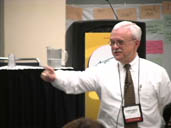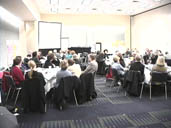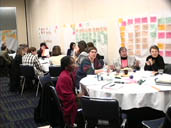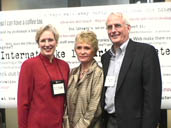 |
| Vol.
17 No. 4 — July/August 2003 |
COVER
STORY
ACRL Sessions Provide Lots of
Marketing Help
by Kathy Dempsey
 |
| Pre-conference leader Ken Marks moved the group at
a quick pace to fit in as much training information as possible. |
I attended the biennial Association of College & Research Libraries (ACRL)
National Conference this spring because its program looked like it would offer
a great deal of help to academic librarians who were struggling to market their
services more effectively. And that was indeed the case. While in Charlotte,
N.C., from April 10 to 13, I picked up a good bit of information that I wanted
to share with all MLS readers. While this conference was for academics,
what I'll write here can also help other librarians and information professionals.
Likewise with the resources I'll name: Even though they may reside on ACRL or
on ALA Web sites, don't ignore what they have to offer you.
Strategic Marketing Pre-Conference
The main event that attracted me to this show was
the daylong pre-conference Strategic Marketing for
Academic and Research Libraries: Train the Trainer.
Those of us who attended emerged as official ACRL
@ your library campaign trainers. ALA's Deborah Davis,
who manages the international @ your library campaign,
reminded those in the full room of the campaign's
importance and was pleased at all the interest—the
pre-conference had sold out and even had a waiting
list. This session's importance was further proven
to me when ACRL president Helen Spalding made a personal
appearance to thank us for our interest and our attendance.
The pre-conference leader was Ken Marks of the
University of NevadaLas Vegas, and he walked
us through books of training information, stopping
sporadically so that each table of attendees could
do exercises and brainstorming under the guidance
of already-trained table leaders. Two representatives
of 3M, the sponsoring vendor, were also there and
they pitched in now and then with their own experiences.
 |
The sold-out crowd filled
the conference room, and each table
full of people was a team. |
"The whole purpose of marketing is to change the
branding that libraries have," Marks explained, adding
that combating people's perceptions of libraries
is "one of the most critical things you have to address."
This session involved far more information than
I could ever write here. In fact, the Strategic Mar-keting
guides contained far more information than we could
go over in a day. So in this report I can simply
share some key points and some ideas that came out
of our brainstorming. Then I'll tell you where to
find more information.
One point that Marks made is that, in your planning
for marketing and for resources, you can't just think
about the upcoming academic year or 18 months. You
need to plan 3 to 5 years out. He also reminded us
that "All undergraduate populations are not the same" and
that you need to identify discrete populations and
figure out what sort of marketing would work for
each. For incoming freshmen, talk to high school
counselors and college recruiters so you can understand
them. Obviously upperclassmen have different needs
and sensibilities. And don't forget to target deans,
boards of regents, etc. Each group really needs its
own separate long-term plan.
If your campus has its own public information office,
you need to market actively to those staff members,
and to make sure that they understand the importance
of your library so that they include it in their
overall promotional efforts. Having your news coming
from an "official" campus source automatically lends
a little more credibility.
Our discussions also pointed out the fact that
we don't market the talents and skills of librarians.
As long as there are people out there who don't know
that you have master's degrees, or wonder why you
need them, you should be promoting your expertise.
It can be especially challenging in an academic environment
where you're surrounded by faculty members who also
have master's or Ph.D.s, but one easy way to start
is to add your degree to your business cards to raise
people's awareness.
 |
The 3M "sticky walls" allowed
each team to easily and quickly post the
results of its many brainstorming sessions. |
At intervals throughout the day, each table full of
attendees did various brainstorming exercises. We identified
groups of customers, discussed what each group needed,
talked about how a library could fill one of those
group's needs, decided which sort of vehicle to use
for delivery, pondered how to guide the target audience
through the process of AIDA (gaining Awareness, building
Interest, creating Desire, resulting in Action), and
then had fun tossing around catchy slogans for the
projects we'd chosen.
Marks discussed much more, such as the different
vehicles for your marketing messages (public relations,
sales promotion, personal selling, direct marketing,
advertising), and they're not concepts that I can
explain fully here. However, ACRL has made a great
many resources available on its Web site:
Start at http://www.ala.org/acrl.
Right on the home page you'll see a link to the Toolkit
for Academic and Research Libraries, which is packed
with basic information. If you want more, from the
home page click on the Issues & Advocacy section,
then on Marketing @ your library. Finally, clicking
on the top choice, Academic and Research Library
Campaign, takes you to a wealth of information including
graphics you can use, suggestions for slogans, case
histories, all the manuals for the new campaign,
a media relations toolkit, a PDF list called 100
Ways to Reach Your Faculty, and even links to studies
and stats on academic library use. I could spend
a whole day reading all the resources and following
all the links.
Regular Sessions That Were Helpful
In a session on the first full day of the show,
James Neal of Columbia University was one of the
speakers talking about The Research & Development
Imperative in the Academic Library. All libraries
can and should play a substantial role in their school's
research and development, which serves to raise their
credibility on campus. "R&D is making discovery
useful," Neal emphasized, which is the exact skill
that librarians have been trained for. Thanks to
this knowledge, "We're becoming much more integral
to the electronic pedagogy that takes place in our
institutions," but librarians must continue to insert
themselves into the research process so they remain
vital to the campus.
 |
Dignitaries pose during a
break in the pre-conference (L-R): ACRL
president Helen Spalding, and representatives of sponsor 3M Judy Nelson
and Don Leslie. |
If you've been wondering just how the Internet affects
libraries, you should've been in the Friday afternoon
session with Amy Friedlander from the Library of Congress.
She discussed a study that the Digital Library Federation
and the Council on Library and Information Resources
commissioned Outsell, Inc. to do to learn more about
how undergrads, grad students, and faculty do research. "What
you think of the Internet has a lot to do with who
you are," she explained. And while access to electronic
info, including that on the Internet, is changing the
way teaching, learning, and researching is done, the
library still matters, at least in academic situations.
To see the whole study and its results, go to http://www.diglib.org/pubs/scholinfo.
On Saturday afternoon I attended a heavy session
on budgets. I heard Antioch University's Alan Guskin
explain a lot about financial and educational models
during Facing the Future: Enhancing Student Learning
and the Vitality of Academic Professionals in a Climate
of Budget Cuts. Guskin began by saying that the "big
economy" of the past decade has covered up basic
flaws in the economic system, and that now universities
need to stop "muddling through" short-term problems
and create viable long-term plans. Since higher education
is all about student learning, and libraries are
about offering those learning tools, then you must
carefully assess your budgets and services to ensure
that they're matching your organization's mission.
Then prove how critical the library is and will continue
to be. Many schools now are trying to decrease the
cost per student, but "You can't keep cutting an
area like the library if the library is to play an
essential role in the future of the organization." You
can read the document that he created with Mary Marcy,
a colleague in Antioch's Project on the Future of
Higher Education, at http://www.pfhe.org.
The home page has a link to the PDF, which contains
stats, principles, quotes, and recommended actions.
A Whole Lotta Learnin' Goin' On
The strength of this conference was shown by its
record-breaking attendance numbers. According to
ACRL, there were over 2,200 registrants and more
than 3,490 total attendees who came from all 50 states,
the District of Columbia, Puerto Rico, and 12 other
countries. As you might guess, this meant standing-room-only
sessions and a busy exhibit hall.
This report merely scratches the surface of all
the marketing, advocacy, and promotional recommendations
that I heard at ACRL's very worthwhile conference.
Check the links I've provided to get more details
so you can customize some plans for your own organization.
 Kathleen L. Dempsey is the Editor
of Marketing Library Services & Computers in
Libraries. Her email address is: kdempsey@infotoday.com Kathleen L. Dempsey is the Editor
of Marketing Library Services & Computers in
Libraries. Her email address is: kdempsey@infotoday.com
|